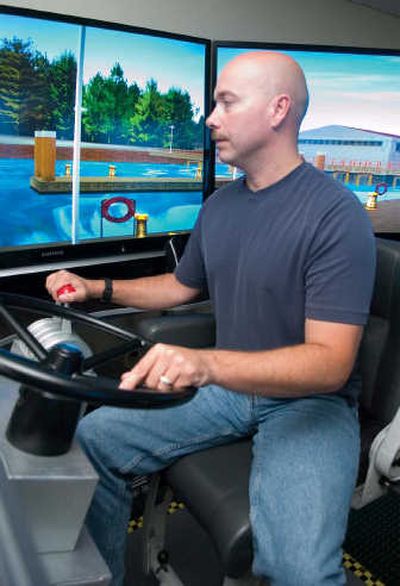Coast Guard tests virtual lifeboat for training exercises

ILWACO, Wash. – With the Pacific Ocean churning around him, Chief Petty Officer Scott Lowry cranks the steering wheel, barrels full-throttle toward a cruise ship – and slams into it.
Without leaving a scratch.
That’s one of the advantages of the motor lifeboat simulator, he said, a fairly new training tool under evaluation at the U.S. Coast Guard’s National Motor Lifeboat School in Ilwaco, Wash., where Lowry is executive officer.
Modeled after the 47-foot lifeboats standard to search-and-rescue jobs off the coast, the machine can mimic most of the surf conditions that have destroyed thousands of ships and earned the Columbia River entrance its nickname: Graveyard of the Pacific.
But Coast Guard boating instructors say there’s no substitute for first-hand experience on the ocean.
“We’re not sure it’s adequate,” Lowry said while demonstrating the simulator’s capabilities, encircled by 360 degrees of 4-foot-wide, flat-screen TVs that fill one of the school’s classrooms. “But it’s pretty neat.”
At the National Motor Lifeboat School, Coast Guard members from across the country learn boat-handling skills and ways to evaluate ocean conditions, with many hoping to achieve surfman status, the highest-ranking class of boat handler.
Using the simulator, students can practice virtually every mission performed by Coast Guard boat crews, from towing disabled fishing vessels and pulling in to dock to maneuvering the lifeboat through heavy surf, rescuing stranded swimmers or escorting large ships across the river bar.
Instructors can manipulate details such as weather, adding rain or snow, and choose between day and night. Programmed to include realistic conditions from off Ilwaco, upriver to Astoria, the software even incorporates local geologic features.
But one question continues to nag boat operators and their trainers, said Lowry: “Why sit in a classroom in a building to drive one when we’ve got five of them sitting out at the dock?”
The answer is twofold: The simulator is intended to increase training opportunities, and to reduce on-duty deaths among boat crews.
“The original justification was fatalities in surf rescues,” explained Scott Thomason, a training specialist and civilian employee at the school.
Since 1961, at least a dozen Coast Guard members have died in accidents off the Oregon and Washington coasts when boats capsized during dangerous rescues. That includes a National Motor Lifeboat School instructor who perished in 1991 at the Columbia River bar, and more recently three members of a surf crew who drowned trying to save people on a sailboat getting battered by a fierce storm.
But simulating ocean conditions also lets students train when the weather is too good.
“Sometimes when we bring classes in Mother Nature doesn’t cooperate, and we don’t get the conditions we need,” said Lowry. “Eight- to 15-foot seas are ideal. We can simulate up to 16-foot surf in here, it’s just not quite as fun as the real thing.”
Still, instructors aren’t confident the simulator won’t undermine training standards.
A full day fighting breaking waves and heavy surf leaves a physical, and sometimes mental, mark, said Petty Officer 1st Class Shawn Winters, an instructor.
“It’s like getting in a minor car wreck,” he said. “You can’t simulate that.”
Winters said decisions are often based on the way a boat feels, which requires experience at the helm.
“That’s how you grow and learn and become a better boat driver,” he said. “In here, you don’t get that. You get a little bit of motion sickness but this,” motioning toward the screens, “is all moving, while you’re not.”
Lowry agreed.
Though the simulator responds the way a lifeboat would to the changing ocean conditions, there’s no pitching with the swells or climbing steep waves, and no way to determine whether a boatswain can stay calm in life-or-death conditions.
“The reactions of the mind and body can’t be simulated,” he said. Inside, “it’s a perfectly safe environment, and you know that. Out there, there are no do-overs.”
The simulator, which the National Motor Lifeboat School has had for almost a year, isn’t part of the school’s curriculum – at least not yet.
Coast Guard officials are currently evaluating the tool and after that, Lowry expects to “have a pretty good idea of whether it will meet our needs,” and whether it might be focused on basic boating skills rather than intense training.
“We’ve had it now the better part of the year, continually updating software and its reactions to throttle and helm controls,” he said. “Now that we’ve almost got it how we want it, we have to figure out what we’re going to do with it.”